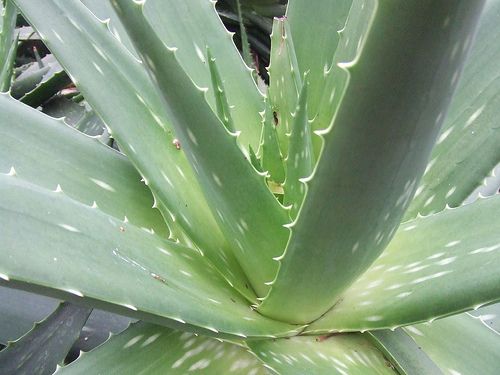
It’s said that Cleopatra claimed aloe vera as one of her greatest beauty secrets. Who am I to argue with Cleopatra?
Apparently aloe is still chosen by leading cosmetic companies for suntan lotions, hand and face creams, as well as shampoos. Beauty isn’t the only valuable gift aloe brings; it’s also known for its remarkable healing properties.
Aloe vera heals and moisturizes skin tissue to the point of even being used to treat radiation burns. Gardeners will often grow them here and there in their gardens so they can use them for cuts, scrapes, burns, or chapped hands at a moment’s notice.
This handy succulent is native to Africa but also grows in China Central America, and Chile. Worldwide, there are 350 species of aloe. The leaves are blades of pale green, very fleshy, and sometimes have spines along the sides. The leaves don’t grow off of a stem, but rather the roots come directly from the base of the plant.
Growing Aloe Vera
Aloes like the full sun, but don’t mind some light shade and once established need very little water. This makes them perfect candidates for xeriscape plantings. In fact, please don’t over water them; the less fuss that’s made over them the better.
The word on the street is that they do well in zones 8, 9 or 12-24. I’m not saying they’re wrong, but you still may have to bring them inside for the winter or at least cover them to keep them protect from the frost. A heavy frost nails them pretty good, in fact, I live in zone 9 and I bring mine under a cover during the cold months.
Aloe vera’s roots like to be crowded, so pot ‘em up! They thrive in pots and amazingly make great indoor plants. If you want more aloes, they’re propagated by taking the little plantlets from alongside the mother plant.
Harvesting Aloe Vera for Medicinal Purposes
Aloe’s healing properties are at their best when used directly from the plant as needed. Some authorities claim that the plant’s gel is strongest in a plant that’s more than 2 years old – but I wouldn’t let the age of the plant stop me from using it.
When the leaf is cut, it’s the clear sap you are looking for that’s so soothing on burns and cuts. It also seals the wound and protects it allowing faster healing. The base of the leaf also contains a yellow sap called “bitter aloes”, which is used as a laxative. Don’t eat that. An interesting point is that people haven’t discovered a way to truly preserve aloe vera for very long once it’s separated from the leaves. The healing property of aloe vera’s gel loses its potency quickly.
Making Aloe Vera Lotion
My 4H Gardening/Plant Science group and I made our own aloe vera lotion. Each kid had their own aloe vera plant and they took a slice or two off of their leaves. We took unscented lotion and mixed it together. Next we added scent (essential oils) and the coloring. We used the same stuff crafty people use to make soap.
We had small purse-size bottles to put the lotion in and they even had oval stickers that they stuck to their lotion bottles afterward. Each 4H-er named their lotions themselves. Kids like to do things with plants – not just planting and watering. One of my favorite things to teach my group is all the health benefits plants bring to us even in these modern times. Today, 25% of all of our prescription medications are derived from plants.
Disclaimer: The information in this article is for informational use only. It is not meant to be a substitute for seeking advice from a medical professional. Serious burns need medical attention immediately.




















Comments
Log in or create an account to post a comment.
Sign up Log in